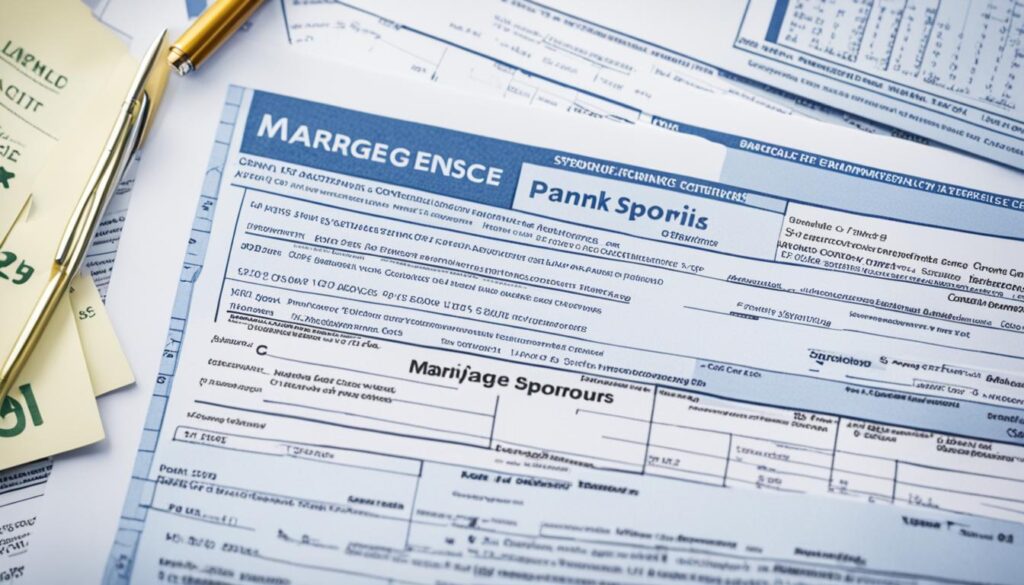The journey to U.S. citizenship is a profound milestone for many, and for residents of Los Angeles, the path through marriage can be both expedient and complex. Understanding the process in LA to acquire citizenship through marriage requires a keen awareness of specific local and federal mandates. This comprehensive guide illuminates the requirements, from the initial stages to becoming a full-fledged citizen.
In LA, the LA citizenship marriage requirements underscore the importance of a genuine conjugal bond with a U.S. citizen and a solid footing of residence on American soil. Delve into the necessary steps to merge love with the pursuit of the American Dream, transcending the bond of matrimony into the realm of civic belonging.
Understanding Citizenship Through Marriage
Embarking on the journey to U.S. citizenship can be particularly unique for those who are doing so through their marital union with a U.S. citizen. This pathway, termed naturalization through marriage, has nuances that set it apart from the standard naturalization processes. Exploring the marriage-based avenue necessitates an understanding of the specific USCIS marriage requirements and how they correlate with overall citizenship through marriage requirements.
Comparing Standard and Marriage-Based Naturalization
At its core, the main distinction between standard and marriage-based naturalization lies in the required period of residency. While the standard route mandates five years of continuous residence, naturalization through marriage offers a reduced stipulation of only three years for those married to U.S. citizens. Importantly, this condensed timeframe is contingent upon the applicant’s ability to prove a genuine marital bond and a joint residence within the United States during this period.
Eligibility Criteria for Citizenship Through Marriage
The eligibility criteria for those seeking citizenship through marriage are meticulously outlined by the U.S. Citizenship and Immigration Services (USCIS). Essential conditions include:
- Being at least 18 years old
- Establishing continuous residence and physical presence in the U.S.
- Demonstrating good moral character
- Being able to read, write, and speak basic English
- Passing a U.S. history and government (civics) test
- Maintaining marital union with the U.S. citizen spouse throughout the three years prior to applying
- Show dedication to the principles of the U.S. Constitution
This comprehensive list enforces the emphasis that marriage-based citizenship applicants must uphold the integrity of their pledge to the United States through adherence to these principles.
Navigating the USCIS Married Pathway
Navigating the USCIS married pathway involves a deep understanding of legal requirements and readiness to furnish the necessary documentation to validate the marriage. Prospective applicants must remain diligent, ensuring that every criterion as stipulated by USCIS, from proving the legitimacy of their marriage to continuous residence within the country, is met with clear evidence. Such careful preparation paves the path to achieving citizenship through a marriage that is recognized under the full faith and law of the United States.
The Essential Role of Form N-400 in Gaining Citizenship
For those seeking to solidify their bond with the United States through naturalization, especially under a spouse visa Los Angeles, the Form N-400, Application for Naturalization, is the cornerstone of the process. As the formal request for U.S. citizenship, this document is not merely a formality but the narrative of your commitment to the nation, detailed in questions that range from personal background to moral character. When married to a U.S. citizen, the information provided within this form is critical as it verifies the authenticity of the marital relationship and the applicant’s eligibility to enjoy expedited citizenship considerations.
Form N-400 requires meticulous attention to detail, requiring the complete and transparent documentation of the applicant’s continuous residence and marital union.
Submission of the Form N-400 for applicants in Los Angeles entails a personal declaration of not just their lawful three-year permanent residence, but also an affirmation of their harmonious marital union. Guidance from reputable services, such as CitizenPath, can be instrumental in navigating through the complexities of USCIS requirements, ensuring each section of the form is completed with precision.
- Personal Information: verification of identity and marital status.
- Residency Details: records confirming continuous residence alongside a U.S. citizen spouse.
- Moral Character: declaration of adherence to the principles of the Constitution and good moral standing.
- English Proficiency and Civics Knowledge: evidence of ability to read, write, speak, and understand English; understanding of U.S. history and government.
Effectively, the completion of Form N-400 is a transformative step. It does more than request citizenship—it demands an illustration of your dedication to your new home, its values, and principles. This form is a pledge, a capstone of the naturalization process, and for those under a spouse visa in Los Angeles, it signifies readiness to undertake the responsibilities and privileges of American citizenship.
Marital Union Requirement for Naturalization
Securing permanent residency through marriage is premised on the concept of living in marital union, a term that may seem straightforward but carries significant legal weight in the context of naturalization. This pivotal requirement forms the bedrock of one’s journey toward becoming a U.S. citizen by marriage, mandating that the applicant and their U.S. citizen spouse make a genuine life together.
Understanding Marital Union and Legal Implications
Achieving permanent residency through marriage is not only about the ceremony and the certificate; it’s about evidencing a shared existence. The marital union requirement stipulates that couples must share a residence and truly live as partners. This condition must be sustained throughout the entire three-year period before filing the naturalization application, underscoring the government’s emphasis on genuine matrimonial relationships.
Factors Impacting the Marital Union Criterion
When assessing adherence to the marital union requirement, certain life events can have a profound impact. To illustrate, here’s a table outlining some of these factors and their potential effects on the naturalization process:
| Event | Impact on Marital Union Requirement |
|---|---|
| Divorce | Terminates the legal marital union and generally disqualifies the applicant from naturalization on the basis of marriage. |
| Legal Separation | May disrupt the perceived continuous marital union, potentially jeopardizing eligibility for naturalization. |
| Annulment | Effectively voids the marital union retroactively, eliminating the basis for naturalization in this context. |
| Death of a U.S. Citizen Spouse | While it terminates the marital union, the surviving spouse may still be eligible under certain circumstances. |
Understanding the pivotal role the marital union criterion holds in the naturalization process carries paramount importance. Disruption of this requirement, for reasons such as divorce or legal separation, often translates into the derailment of an individual’s pathway to citizenship via marriage. As such, it’s essential to maintain the shared life that qualifies one for permanent residence and, eventually, citizenship status.
Citizenship Through Marriage: Process in LA
Navigating the citizenship through marriage process in LA requires a precise understanding of the intricate rules and procedures enforced by the United States Citizenship and Immigration Services (USCIS). The journey from obtaining a green card to becoming a full-fledged citizen is multi-faceted, involving several crucial steps to ensure successful naturalization through the spouse sponsorship process. Clarifying these steps can help applicants anticipate what’s required and appropriately prepare for each phase of their citizenship journey.
The process is not solely about paperwork; it’s a testament to one’s dedication to building a life in Los Angeles with their spouse. It’s governed by regulations meant to validate the authenticity of the marital bond and the applicant’s commitment to the principles and values upheld in the United States.

Particular attention is given to cases involving hardships such as domestic abuse. The USCIS recognizes the plight of individuals subjected to battering or extreme cruelty by their US citizen spouses, and provisions are in place to offer protection and support throughout the application process for these applicants.
- Deep understanding of USCIS guidelines
- Preparation of legal documentation
- Knowledge of residency requirements
- Awareness of travel restrictions
- Insight into individual and marital eligibility nuances
Applicants often find it challenging to decode the multi-layered USCIS directives that govern their circumstances. This is where thorough research, and for many, professional guidance, becomes indispensable.
| Phase | Step | Description |
|---|---|---|
| Initial | Eligibility Assessment | Review of USCIS criteria for eligibility under marriage provisions. |
| Documentation | Collection of Evidence | Gathering of necessary documentation proving the marital relationship and continuous residence. |
| Filing | Application Submission | Completion and submission of Form N-400 and related paperwork. |
| Interview | Scheduled USCIS Interview | Attending the appointment to demonstrate eligibility for naturalization. |
| Final | Oath of Allegiance | Participation in the naturalization ceremony and taking the Oath of Allegiance to finalize citizenship. |
In conclusion, those who seek to understand the citizenship through marriage process in LA will be better equipped to navigate its complexities. Their journey may involve arduous steps and rigorous requirements ranging from the initial eligibility check to the final naturalization ceremony. Nonetheless, this path holds the promise of a new chapter as a U.S. citizen alongside their loved one.
The Three-Year Permanent Residency Rule Explained
For individuals pursuing U.S. citizenship through marriage, understanding and adhering to the three-year permanent residency rule is essential. This critical regulatory chapter outlines the requirement for aspiring citizens to maintain a continuous residence within the United States. By ensuring a consistent and uninterrupted physical presence, applicants affirm their commitment to their new homeland while solidifying the basis for their future citizenship.
Underscoring Continuous Residence
Continuous residence means that the applicant must live within the country without extended breaks. It’s indicative of the individual’s intent to reside permanently in the U.S. and sets the stage for successful integration into society. It does not, however, prevent routine, short-term travels.
Travel Restrictions and Preserving Residential Continuity
The stringent nature of the continuous residence requirement holds especially true when it comes to prolonged absences. Long durations of travel outside U.S. borders, notably those exceeding 180 days, are scrutinized and can play a pivotal role in the decision-making process of the USCIS. Such extensive periods of absence often raise questions about the applicant’s dedication to maintaining continuous residency and could potentially reset the three-year residency clock.
- Maintain a record of all travels outside the U.S.
- Plan for brief trips and avoid lengthy stays abroad.
- Keep evidence of your ties within the community to showcase continuous residence.
- Stay informed about policy changes that may affect the continuous residence requirement.
By thoroughly respecting the continuous residence requirement and keeping extended travels in check, applicants will be well-positioned to showcase their eligibility under the three-year permanent residency rule. It establishes the foundation for a successful application that leads to embracing the rights and responsibilities of U.S. citizenship.
Physical Presence: A Key Factor in Acquiring Citizenship
The journey towards U.S. citizenship is paved with various legal stipulations, among which the physical presence requirement for citizenship stands prominent, especially for those navigating the path through a spouse visa in Los Angeles. Adherence to the physical presence guideline is more than just a formality; it’s a testament to an applicant’s commitment to residing within the nation’s borders and genuinely participating in the daily life and culture of the United States.

Calculating Your Physical Presence in the US
For individuals applying for citizenship on account of marriage to a U.S. citizen, the calculation of their physical presence is a crucial step. It entails mapping out all the time spent on American soil during the three-year period prior to the submission of Form N-400. It’s essential that this time amounts to at least 18 months, but the more time spent stateside, the stronger the application. This is not a mere counting exercise but a critical element evaluated by the United States Citizenship and Immigration Services (USCIS).
Documenting Your Travels During the Qualification Period
Meticulous documentation is the key to validating your physical presence. All trips outside the U.S. should be recorded with precision including departure and return dates. The USCIS requires this data not only to verify the duration of your travels but also to ensure those periods do not exceed the allowable timeframe that might otherwise break the continuous residency requirement.
- Detail every trip abroad with corresponding dates
- Keep boarding passes and ticket stubs as additional evidence of your travels
- Maintain a log of any extended stays outside the country
In conclusion, completing the physical presence requirement efficiently is a decisive step on the road to citizenship via a spouse visa in Los Angeles. Every day within the U.S. borders counts, and every trip outside must be accounted for with utmost accuracy in the pursuit of the American Dream.
Early Naturalization: The 90-Day Early Filing Provision
The journey towards becoming a U.S. citizen through marriage is marked by numerous milestones and procedural points, one of which is the early naturalization provision. Recognizing the significant milestone this represents for applicants, the USCIS has instituted a means by which the pathway to citizenship can be initiated slightly ahead of the standard schedule. This is known as the 90-Day Early Filing Provision. Under this provision, individuals can submit their Form N-400, Application for Naturalization, up to 90 days before they complete the requisite three-year period of continuous residence that follows marriage to a U.S. citizen.
Fulfilling USCIS marriage requirements is a complex process intertwined with strict timelines and regulations. The early filing provision presents an opportunity to get ahead in the application process. However, it is vital for applicants to understand that while they may submit their application in advance, the USCIS mandates that they still fulfill all the eligibility criteria, including completing the full three-year period of residency, before recognition of their naturalized status is granted.
Below is a summarized highlight of the benefits and considerations associated with the early filing provision:
- It allows for a head start in the naturalization application process.
- The USCIS will accept the N-400 application 90 days before the three-year residency completion.
- Applicants gain additional time to prepare for the subsequent steps of the naturalization process, such as the interview and citizenship test.
- No early finalization — all standard naturalization requirements, including the full three-year duration of continuous residency, remain in effect and must be regarded in full.
For spouses of U.S. citizens eager to cement their bond to the nation and its values through citizenship, this early filing is a welcome provision. Prospective applicants are nevertheless encouraged to ensure diligent adherence to all other USCIS stipulations surrounding marriage and residency to ensure the integrity and success of their application.
Application Options: Marital vs. Long-term Residency
When en route to American citizenship, individuals who are married to U.S. citizens confront a pivotal decision: should they apply for citizenship based on their marriage or opt for the route of long-term residency? This choice carries significance, as each path bears its own set of requirements and nuances.
Choosing Between Citizenship Pathways
The journey to citizenship through marriage is a pathway dedicated to those who have anchored their lives to a U.S. citizen by matrimonial bonds. Applying for citizenship based on marriage often expects candidates to supply extensive evidence of their marital union. This typically includes joint financial statements, proof of residence, and additional documentation that affirms the legitimacy and ongoing nature of the marriage.
Conversely, the option to pursue citizenship after five years of permanent residency stands as a separate course, one which many find less complex in terms of the evidence required. This path necessitates a well-documented trail of the individual’s residency history but does not require verification of marital ties. Hence, for those who value a straightforward application process devoid of the complexities of proving marriage legitimacy, this might be a preferable route.
The Pros and Cons of Each Approach
Embarking on the citizenship route through marriage undoubtedly accelerates the timeline for many applicants. Yet, this acceleration is often balanced by the onus of furnishing proof that the marriage is genuine and not orchestrated for the sole purpose of facilitating immigration benefits—a hurdle that some may find daunting.
In contrast, the permanent residency path extends the wait time but reduces the potential complications related to furnishing proof of marriage. This is an avenue predominantly characterized by the documentation of individual residency status and compliance with general naturalization standards like language proficiency and understanding American civics.

The decision between these citizenship application options should not be made hastily. It is recommended that individuals carefully reflect on their unique circumstances, marital stability, and the documentation they can provide. Immigration consultants or attorneys can provide tailored insights and guidance, helping applicants to resolve which pathway aligns best with their situation.
Ultimately, while applying for citizenship based on marriage versus residency may lead individuals down distinct procedural avenues, both converge on the common destination of U.S. citizenship—the cherished culmination of an immigrant’s journey.
The Green Card Process Through Marriage
Navigating the path to permanent residency in the United States through marriage requires a detailed understanding of the legal framework and procedures. Specifically, for those based in Los Angeles or engaged in the green card process through marriage, the initial phase begins with the all-important Petition for Alien Relative. This petition lays the foundation for a spouse visa in Los Angeles, moving towards the ultimate goal of achieving lawful permanent residency.
From the Petition for Alien Relative to Adjustment of Status
The primary step in securing a green card through marriage involves submitting a Form I-130, also known as the Petition for Alien Relative. This form serves as an official request from the U.S. citizen or lawful permanent resident spouse to recognize their foreign-national spouse as an eligible candidate for a green card. Upon approval of this petition, the process leads to the next crucial phase—Adjustment of Status for those within the United States, demonstrated through the submission of Form I-485.
An Adjustment of Status (AOS) is the procedure that allows the foreign-national spouse currently in the U.S. to apply for lawful permanent residence without needing to return to their home country. This transition is a pivotal moment in the green card process through marriage and demands meticulous documentation, including evidence of the marriage’s authenticity and the petitioner’s ability to support their spouse financially.
Consular Processing for Foreign Residents
For partners residing outside the United States, the green card process follows a different route known as consular processing. Once the Petition for Alien Relative is approved, the foreign-national spouse will complete their visa application and attend an interview at the U.S. Consulate in their home country. This procedure aims to assess their eligibility and the marriage’s validity before granting a spouse visa that leads to permanent residency upon entry into the United States.
Both Adjustment of Status and consular processing are integral steps within the green card process through marriage and require comprehensive legal knowledge and preparation. Those seeking a spouse visa in Los Angeles can benefit from specialized legal services to navigate these complex procedures.
| Component | Explanation | Relevance to Applicant |
|---|---|---|
| Petition for Alien Relative (I-130) | Initial request to recognize foreign spouse for green card eligibility. | Must be filed and approved before AOS or consular processing can commence. |
| Adjustment of Status (I-485) | Application for residency without leaving the U.S. | For applicants currently in the U.S. seeking to adjust from a temporary to permanent status. |
| Consular Processing | Visa application and interview at a U.S. consulate abroad. | For foreign-resident spouses to enter the U.S. as permanent residents upon approval. |
Documentation and Supporting Evidence for Spouse Sponsorship
Gathering the right documentation for spouse sponsorship is a pivotal aspect of the spouse sponsorship process in LA. It involves a detailed compilation of key documents that support both Form I-130, Petition for Alien Relative, and Form I-485, Application to Register Permanent Residence or Adjust Status. This documentation validates the legitimacy of the marital union and the eligibility of the sponsoring spouse, making it a linchpin in the application’s success.
Gathering Essential Documents for Form I-130 and I-485
Applicants must meticulously prepare and organize all necessary documents to avoid delays in their spouse sponsorship endeavor. The significance of the Form I-130 and I-485 supporting evidence cannot be overstated in exemplifying the authenticity of the marital relationship.
| Type of Document | Purpose | Details |
|---|---|---|
| Citizenship or Permanent Residency Proof | Verifies the status of the sponsoring spouse | Includes passport, birth certificate, or Green Card |
| Marriage Certificate | Confirms the legality of the marriage | Must be government-issued and include date and place of marriage |
| Prior Marriage Terminations | Shows eligibility to marry | Divorce decrees, death certificates, or annulment papers |
| Financial Records | Demonstrates shared financial responsibilities | Joint bank statements, credit card bills, and loan documents |
| Proof of Cohabitation | Illustrates the couple’s shared life | Utility bills, lease agreements, and property deeds showing both names |
| Photographs | Adds a visual element of proof for the relationship | Photos from the wedding, trips, holidays, and daily life together |
Understanding the Role of Evidence in Proving a Genuine Marriage
The purpose of the extensive documentation for spouse sponsorship goes beyond mere formality. These documents serve to substantiate the validity of the marriage to the USCIS, ensuring the foundation of the union is genuine and built on mutual commitment rather than circumventing immigration laws. It’s important for applicants to recognize that understated nuances and particulars within the evidence can significantly influence the application’s approval.

Conclusion
The journey to achieving citizenship through marriage in LA is a rigorous yet navigable pathway that demands comprehensive familiarity with the USCIS’s standards and processes. For those who have embarked on this journey, earning the coveted status of a citizen reflects not just a change in legal standing, but a deep commitment to a shared life in the United States. Every stage of the naturalization process in LA, from validating the legitimacy of a marital bond to satisfying the three-year residency mandate, is imbued with the principle that the progression toward permanent residency through marriage must be underpinned by genuine intention and verifiable continuity of residency.
It is imperative that applicants approach the application procedure with precision, providing all necessary documentation and proof to affirm the bona fides of their union. From the minutiae of Form N-400 to the scrutiny of the final interview, every facet of the process serves a purpose – to ensure that the pathway to citizenship through marriage in LA is constructed on a foundation of truth and dedication. As such, thorough preparation and adherence to the designated criteria are essential for success.
The culmination of this exacting process is not just a testament to the strength of a marital partnership but is also a gateway to new rights and responsibilities as Americans. It is this transformation, achieved through meticulous adherence to policy and procedure, that exemplifies the integrity of the naturalization process in LA. Thus, partnerships rooted in authenticity and fortified by a strict compliance with the legal requisites not only meet the USCIS requirements but symbolize the entrants’ unwavering resolve to build their futures on American soil.
FAQ
Q: What are the requirements for citizenship through marriage in LA?
A: To qualify for citizenship through marriage in Los Angeles, you must be married to a U.S. citizen and have lived in marital union with them for at least three years prior to filing. You must also meet other eligibility criteria such as being 18 or older, maintaining continuous residence and physical presence in the U.S., and having good moral character.
Q: How does marriage-based naturalization differ from standard naturalization?
A: One of the main differences is the residency requirement: marriage-based naturalization applicants can apply after three years of permanent residency instead of the standard five years. They must also provide evidence of a genuine marital union with their U.S. citizen spouse.
Q: What is Form N-400 and why is it important?
A: Form N-400, Application for Naturalization, is the form used to apply for U.S. citizenship. It’s critical to the citizenship process because it collects detailed information about your eligibility, residence, physical presence, and marital union, which USCIS reviews to determine your suitability for naturalization.
Q: What constitutes living in marital union for the purposes of naturalization?
A: Living in marital union means that you and your U.S. citizen spouse reside in the same household. This living arrangement must be maintained for at least three years leading up to your naturalization application and any period of separation could impact your eligibility.
Q: How long must I physically be present in the U.S. to qualify for citizenship through marriage?
A: You must have physically resided in the United States for at least 18 months of the three years immediately preceding your Form N-400 application date.
Q: Can I file for naturalization early if I am married to a U.S. citizen?
A: Yes, you can file Form N-400 up to 90 days before completing the mandatory three-year period of continuous residence, under the 90-Day Early Filing Provision. However, all eligibility requirements, including the full three-year period, must be met by the time USCIS finalizes your naturalization.
Q: Should I apply for citizenship based on marriage or after five years of residency?
A: This depends on your circumstances. If you are married to a U.S. citizen and meet the criteria, applying based on marriage allows you to apply earlier. However, if you prefer a potentially simpler process without needing to prove the marital relationship, you may choose the five-year residency pathway.
Q: What is the initial step in the green card process through marriage?
A: The initial step in the green card process for spouses is filing the Petition for Alien Relative (Form I-130). Once approved, this will lead to filing for an Adjustment of Status (Form I-485) if the applicant is in the U.S., or to consular processing if they are abroad.
Q: What evidence is required to prove a genuine marriage for spouse sponsorship?
A: Evidence to prove a genuine marriage includes but is not limited to joint lease or mortgage documents, joint bank accounts, insurance policies, photos of the couple together, and affidavits from friends or family members attesting to the authenticity of the marriage.
Q: Can long trips outside the U.S. affect my eligibility for citizenship through marriage?
A: Yes, trips of 180 days or more may disrupt your continuous residence, which is a requirement for naturalization. It is important to maintain your home in the U.S. and to have evidence supporting your continued ties to the U.S. during any lengthy trips abroad.

